
By: Pramod Kumar
Chandraleela Jasinthan was a school teacher in a northern Sri Lankan village when, in the last days of the civil war, she and her neighbours were forced to flee their homes by the army.
More than a decade later, their land is still held by the military.
Jasinthan and dozens of other women in Keppapilavu have been staging a protest for more than three years at the entrance to the army camp which they say sits on their ancestral land, one of the longest protests in the country.
“The men say they have to work, that they are afraid of the army. But for us women, this land is our security, our right – if we do not fight for it, who will?” said Jasinthan, 43.
“We lost everything in the war; why must we also lose the land we have lived on for generations? These are our homes, our livelihoods,” she said.
Thousands of people were killed in the war, which ended in May 2009 after nearly three decades. Many of those who fled or were forced from their homes in the north and east of Sri Lanka had their properties seized, according to human rights groups.
Former President Maithripala Sirisena vowed to return all private land held in the northern and eastern provinces by Dec. 31, 2018. But the deadline was not met, according to land rights groups.
In Keppapilavu, nearly 350 acres of land is yet to be released, according to the People’s Alliance for Right to Land.
About 85% of the private lands in the north and east held by armed forces “have already been handed over to the legitimate owners,” said Chandana Wickramasinghe, an army spokesman.
The remaining land is of “tactical importance” and is vital for national security, he said.
“Hence releasing the remaining lands will depend on the situation subsequent to the accessing of security parameters. Therefore a timeline is not a matter that can be discussed at present,” he told the Thomson Reuters Foundation in emailed comments.
During the war, tens of thousands of Sri Lankan Tamils sought refuge in neighbouring India, particularly in the southern state of Tamil Nadu.
The United Nations’ refugee agency (UNHCR) began facilitating their return to Sri Lanka from 2011, and has so far helped 8,529 refugees return, said Menique Amarasinghe, UNHCR’s country representative.
Several thousand refugees have also returned by themselves.
Nearly 100,000 Sri Lankan Tamils still live in India, many in camps.
More than two-thirds of returning refugees are landless, according to human rights groups. About 30,000 people are still considered internally displaced, many of whom have lost their homes and land.
Restitution of land is critical to peace-building as it recognises violations and ensures the restoration of rights, including freedom of movement and an adequate standard of living, according to the Centre for Policy Alternatives (CPA), a think tank in Colombo.
“In the Sri Lankan context, land is a critical aspect of one’s identity and belonging,” said Bhavani Fonseka, head of research and advocacy at CPA.
“Reparations, including the restitution of land if implemented correctly, can contribute to long-term peace-building efforts and prevent further marginalisation of war–affected communities,” she said.
Sri Lankan authorities promised returning refugees a small plot of land, but it can be a long wait.
Others have taken matters into their own hands.
About 100 former residents of the northern island of Iranaitivu, who had been uprooted in 1992 by the army, had been living on the mainland for years, returning to the island to fish and harvest coconuts.
While they had hoped to return to their homes in 2009 after the war ended, the Sri Lankan Navy said the island was of strategic importance, and barred them from returning.
After numerous petitions, women – particularly widows who had struggled to make a living without easy access to the island – staged a year-long protest from 2018, demanding the return of their land.
Last year, supported by the local Catholic church, former residents of Iranaitivu boarded more than two dozen boats to the island and occupied their land peacefully.
The Navy conceded, retaining a small area for its use. More than 100 former residents now live on the island. They are campaigning to get the Navy off the island entirely, said Maria Jeyaseelan, one of the protest leaders.
“We are once again able to farm and fish and earn a living, even if we are not living as well as before,” she said. “But our wish is to get back all our land.”
For Jasinthan and the other women protesting for the return of their ancestral land in Keppapilavu more than 100 kilometres (62 miles) away, women like Jeyaseelan and Singharatnam give them hope.
Jasinthan has been summoned to court several times – including the day after her husband died – because of the protests. She said she has received threats, and has installed security cameras at her home and acquired a pair of guard dogs.
“As a widow, it is harder to go against the army. But this land is all we have, so we are going to continue to protest till we get it back,” she said.
(Reuters)